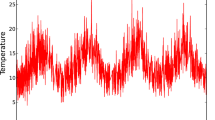Abstract
Paleoclimate records are extremely rich sources of information about the past history of the Earth system. We take an information-theoretic approach to analyzing data from the WAIS Divide ice core, the longest continuous and highest-resolution water isotope record yet recovered from Antarctica. We use weighted permutation entropy to calculate the Shannon entropy rate from these isotope measurements, which are proxies for a number of different climate variables, including the temperature at the time of deposition of the corresponding layer of the core. We find that the rate of information production in these measurements reveals issues with analysis instruments, even when those issues leave no visible traces in the raw data. These entropy calculations also allow us to identify a number of intervals in the data that may be of direct relevance to paleoclimate interpretation, and to form new conjectures about what is happening in those intervals—including periods of abrupt climate change.
Access this chapter
Tax calculation will be finalised at checkout
Purchases are for personal use only
Similar content being viewed by others
Notes
- 1.
Since ice sheets preferentially collect \(^{16}\mathrm {O}\), while oceans preferentially collect \(^{18}\mathrm {O}\).
- 2.
The accumulation data from the WDC has not yet been released publicly, so we cannot include a plot of it here, but there are some extremely interesting correspondences that we hope to be able to include in a few months, when we are allowed to share those data.
References
Alley, R., et al.: Abrupt climate change. Science 299, 2005–2010 (2003)
Bandt, C., Pompe, B.: Permutation entropy: a natural complexity measure for time series. Phys. Rev. Lett. 88(17), 174102 (2002)
Bollt, E., Stanford, T., Lai, Y.C., Życzkowski, K.: What symbolic dynamics do we get with a misplaced partition?: on the validity of threshold crossings analysis of chaotic time-series. Physica D 154(3), 259–286 (2001)
Buizert, C.: The WAIS divide deep ice core WD2014 chronology–Part 1: methane synchronization (6831 ka BP) and the gas age-ice age difference. Clim. Past 11, 153–173 (2015)
Cao, Y., Tung, W., Gao, J., Protopopescu, V., Hively, L.: Detecting dynamical changes in time series using the permutation entropy. Phys. Rev. E 70(4), 046217 (2004)
Dakos, V., et al.: Slowing down as an early warning signal for abrupt climate change. Proc. Nat. Acad. Sci. 105(38), 14308–14312 (2008)
Dansgaard, W.: Stable isotopes in precipitation. Tellus 16, 436–447 (1964)
Dansgaard, W., et al.: Evidence for general instability of past climate from a 250-kyr ice-core record. Nature 364, 218–220 (1993)
Dansgaard, W., Johnsen, S., Clausen, H., Gundestrup, N.: Stable isotope glaciology. Medelelsser om Gronland 197, 1–53 (1973)
Dansgaard, W., White, J., Johnsen, S.: The abrupt termination of the younger Dryas climate event. Nature 339, 532–534 (1989)
Fadlallah, B., Chen, B., Keil, A., Príncipe, J.: Weighted-permutation entropy: a complexity measure for time series incorporating amplitude information. Phys. Rev. E 87(2), 022911 (2013)
Kraskov, A., Stögbauer, H., Grassberger, P.: Estimating mutual information. Phys. Rev. E 69(6), 066138 (2004)
Lenton, T., et al.: Early warning of climate tipping points from critical slowing down: comparing methods to improve robustness. Philos. Trans. R. Soc. Lond. A: Math. Phy. Eng. Sci. 370(1962), 1185–1204 (2012)
Mantegna, R., Buldyrev, S., Goldberger, A., Havlin, S., Peng, C., Simons, M., Stanley, H.: Linguistic features of noncoding DNA sequences. Phys. Rev. Lett. 73(23), 3169–3172 (1994)
Petit, J., et al.: Climate and atmospheric history of the past 420,000 years from the Vostok ice core, Antarctica. Nature 399, 429–436 (1999)
Scheffer, M., et al.: Early-warning signals for critical transitions. Nature 461, 53–59 (2009)
Schreiber, T.: Measuring information transfer. Phys. Rev. Lett. 85(2), 461–464 (2000)
Shannon, C.: Prediction and entropy of printed English. Bell Syst. Tech. J. 30(1), 50–64 (1951)
Sigl, M., et al.: The WAIS Divide deep ice core WD2014 chronology–part 2: Annual-layer counting (031 ka BP). Clim. Past 12, 769–786 (2016)
WAIS Divide Project Members: Onset of deglacial warming in west antarctica driven by local orbital forcing. Nature 500, 440–444 (2013)
WAIS Divide Project Members: Precise interpolar phasing of abrupt climate change during the last ice age. Nature 520, 661–665 (2015)
White, J., et al.: Abrupt impacts of climate change: Anticipating surprises. In: EGU General Assembly Conference Abstracts, vol. 16, p. 17028 (2014)
Winstrup, M., et al.: An automated approach for annual layer counting in ice cores. Clim. Past 8, 1881–1895 (2012)
Author information
Authors and Affiliations
Corresponding author
Editor information
Editors and Affiliations
Rights and permissions
Copyright information
© 2016 Springer International Publishing AG
About this paper
Cite this paper
Garland, J., Jones, T.R., Bradley, E., James, R.G., White, J.W.C. (2016). A First Step Toward Quantifying the Climate’s Information Production over the Last 68,000 Years. In: Boström, H., Knobbe, A., Soares, C., Papapetrou, P. (eds) Advances in Intelligent Data Analysis XV. IDA 2016. Lecture Notes in Computer Science(), vol 9897. Springer, Cham. https://doi.org/10.1007/978-3-319-46349-0_30
Download citation
DOI: https://doi.org/10.1007/978-3-319-46349-0_30
Published:
Publisher Name: Springer, Cham
Print ISBN: 978-3-319-46348-3
Online ISBN: 978-3-319-46349-0
eBook Packages: Computer ScienceComputer Science (R0)




